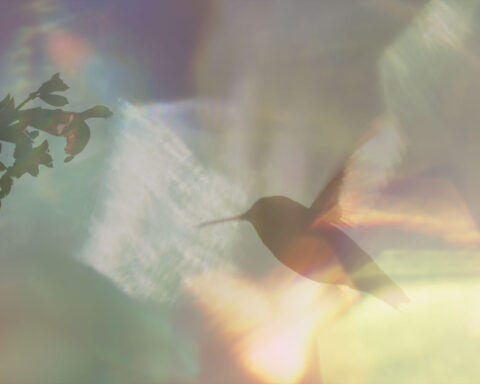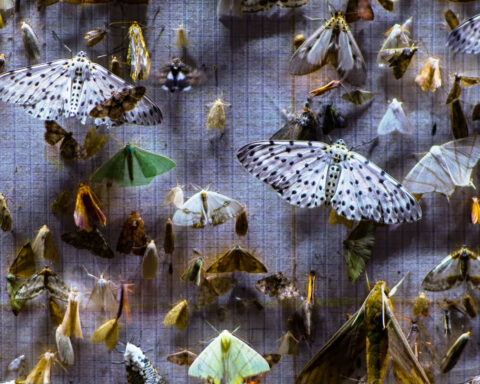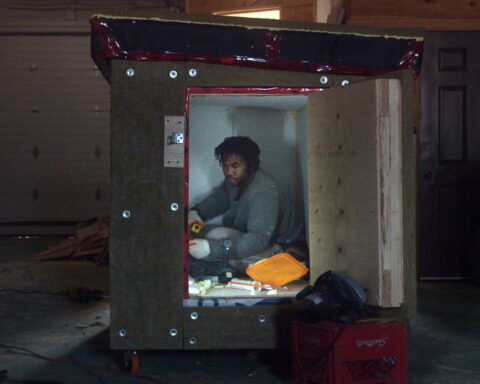Safari
(Austria, 90 min.)
Dir. Ulrich Seidl
Programme: Masters (North American Premiere)
Featuring: Gerald Eichinger, Eva Hofmann, Manuel Eichinger, Tina Hofmann, Manfred Ellinger, Inge Ellinger, Volker Neemann, Marita Neemann, Markolf Schmidt, Eric Müller
Ulrich Seidl bags some prize beasts in Safari. The master filmmaker is an expert guide on the plains of Africa, as he uses his keen intuition to direct his mighty hunter, cinematographer Wolfgang Thaler, who wields a camera like a marksman does a Timber Classic. Safari takes aim at ignorance, puts it in the crosshairs, and pulls the trigger, but Seidl ensures that moviegoers do something that a sporting hunter might fail do. He gets the audience to empathise with the animals within the frame as the filmmaker presents us with a leisurely safari hunting “wildebeests” and giraffes.
The doc takes audiences along a nimble journey as Seidl joins some bands of Austrian and German tourists who embark on safari vacations in South Africa and Namibia. The director offers a series of tableaux shots that capture the amateur hunters in their habitat as they soak up the sun, snore in a blind, talk about tasty meats, and search for wild game. The film observes the thrill of the hunt as the tourists, which includes a family of keen sharpshooters, pursue animals at whose beauty they marvel before aiming for the kill.
Safari documents the elements of ritual that the hunt entails as the elder mother and father of the family congratulate one another with hunters’ kisses after every kill. Killshots rarely feel so cold and visceral as they do when the amplified reports of the hunting rifles offer deafening cracks. One jolts in one’s seat as the violence viscerally marks another life taken in the name of sport. On the other hand, Seidl handily conveys the adrenaline rush of the safari chase as fluid cinematography and urgent handheld camerawork provide a first-person point of view from the front lines of the hunt. It’s a rush.
The film shows only a handful of live animals at a distance with which one may see the same majesty that the hunters admire between their scopes. Safari, however, features ample photo shoots in which the hunters pose with their prized kills, displaying their guns and bounty as they relish the spoils of the hunt. These images of safari selfie culture are entitlement in a snapshot. Similarly, the tourists convey their wilful ignorance to the consequences of their sport, as they use words like “sweat” instead of blood and other euphemisms to blind them from the fact that they’re shooting animals for the thrill of the kill.
Without commenting on their behaviour or even using montage to make associations, Safari simply lets the action play out naturally in long takes—-capturing the depths of depravity that set people apart from animals. Gluttony is on full display with rotund tourists who recite the price of prime cuts of meat while sunning their bellies like cats in the yard. Cultural prejudice is plainly evident as lodge keepers and tourists debate the differences between whites and blacks, saying things like “blacks can run faster—when they want to” all the while insisting on their open-mindedness.
Safari offers many opportunities to laugh both with and at the tourists who find their passion behind the trigger. Most striking are Seidl and Thaler’s portraits of the subjects as they recount their stories in interviews or simply sit and stare vacantly as the camera observes them like gazelles in the wild. These droll tableaux shots mount the tourists like heads on a wall.
The director introduces bold juxtapositions midway through Safari. The film gradually cuts to the activity of the black workers who do the hard work to fuel the passion of these hunters. Images of the workers skilfully skinning and butchering a prized animal, for example, show the reality of the hunt—the slaughter—that the hunters do not see.
Seidl captures portraits of the workers that are similar in composition to those of the hunters, but the tone differs greatly as those images emphasise a connection to the land and an appreciation of the animals as living creatures. The workers show the practical worth of the animals as they dry pieces of hide and chew voraciously on bones, thus ensuring that little of the precious animals go to waste. The real animals on display in Safari are not the non-human ones but the beasts with the guns.
Safari screens:
-Saturday, Sept. 10 at 7:30 PM at Cineplex Scotiabank
-Monday, Sept. 12 at 4:45 PM at Jackman Hall
-Sunday, Sept. 18 at 3:45 PM at Cineplex Scotiabank
TIFF runs Sept. 8 – 18. Please visit tiff.net for more information.











